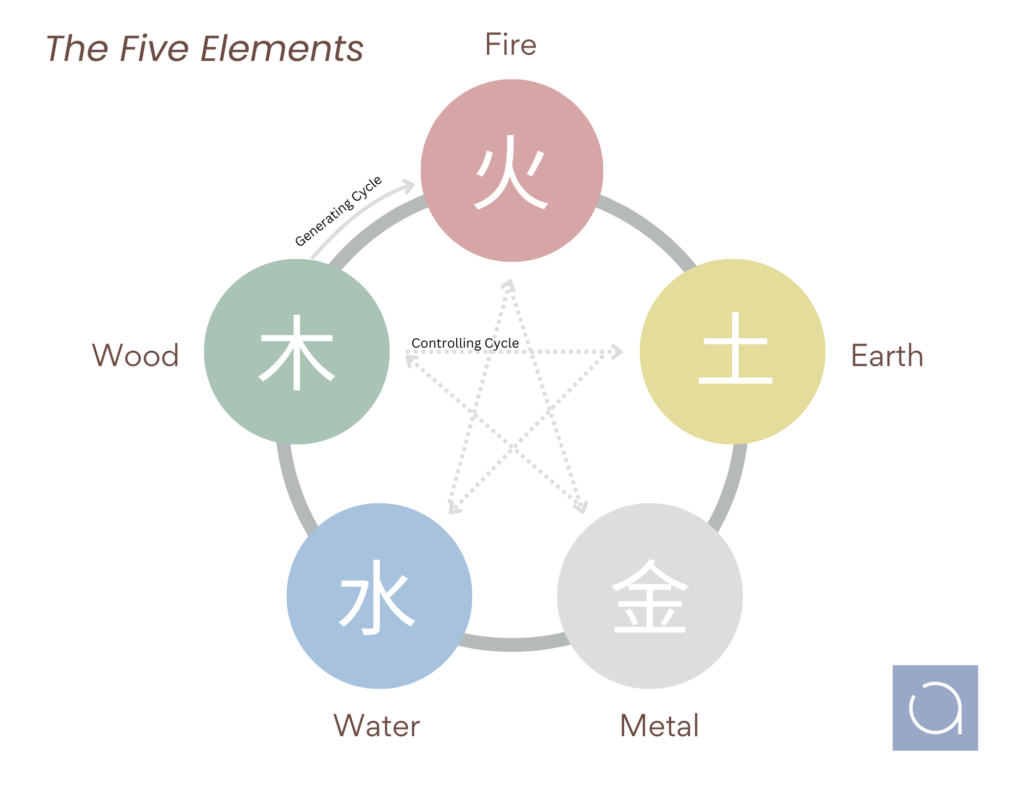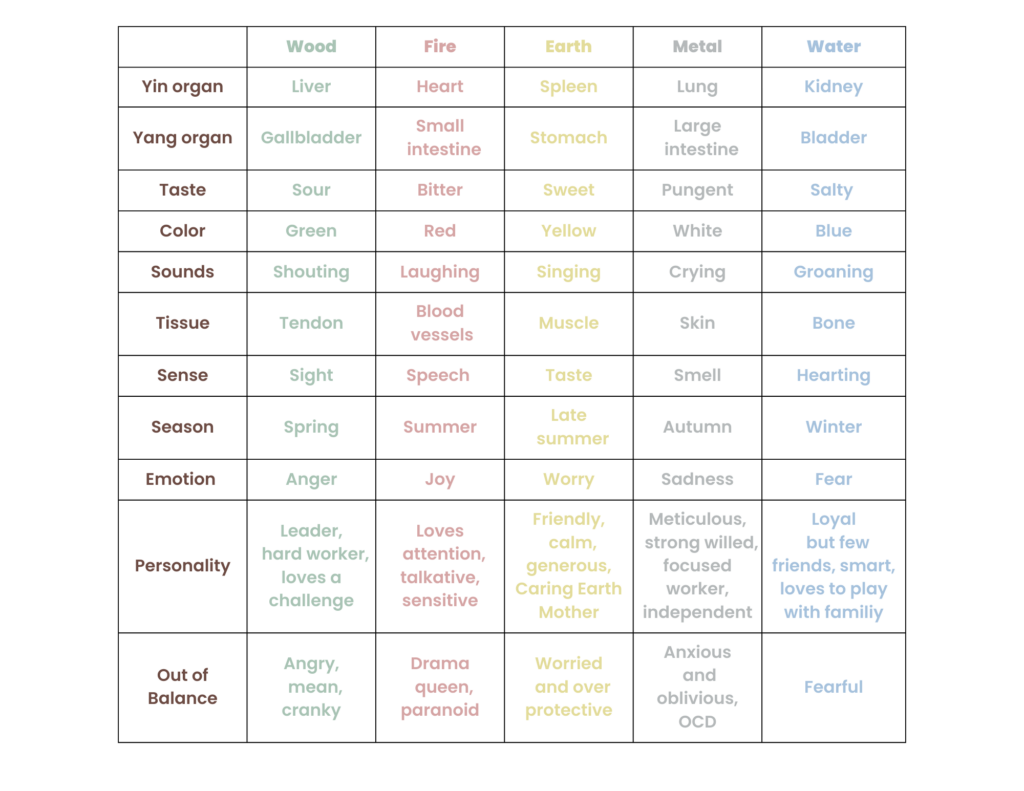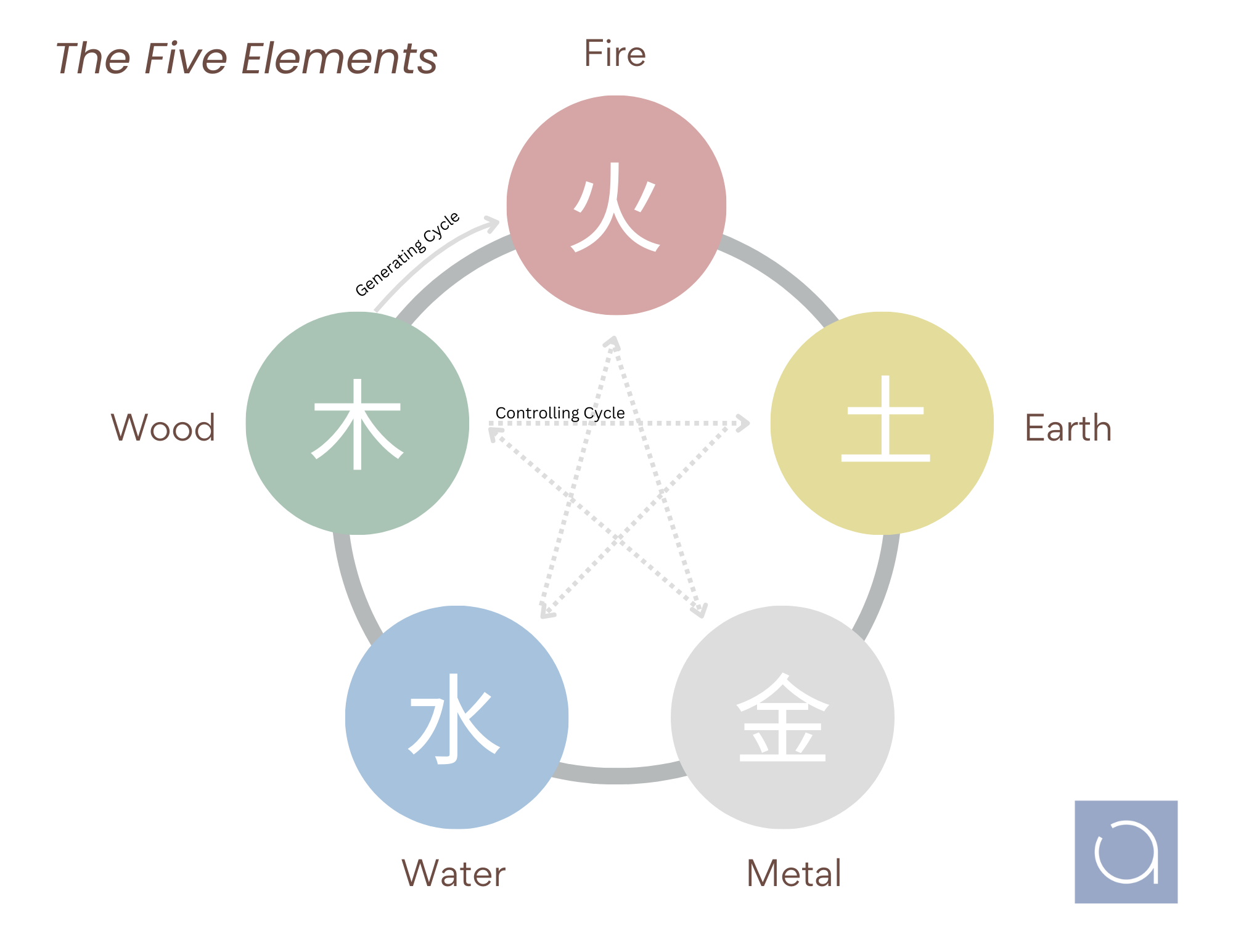In Chinese medicine, the body is seen as a reflection of nature, and the balance within our bodies is influenced by the dynamic forces of the natural world. One of the core frameworks used to understand and treat imbalances in Chinese medicine is the Five Element (or Phases) Theory (Wu Xing). Xing means to walk or to move, and therefore when the word ‘Element’ or ‘Phase’ is used to describe the movement or quality of qi that represent the fundamental qualities of all matter in the universe. This theory categorizes everything in the universe—and within us—into five elements: Wood, Fire, Earth, Metal, and Water. Each element has unique qualities and associations that inform how Chinese medicine practitioners approach physical, emotional, and spiritual health.
Let’s explore how each element is connected to different aspects of health, emotions, and organ systems, and how understanding this theory can deepen our approach to wellness.

What Are the Five Elements?
Each element in Chinese medicine has specific correspondents that are linked to certain qualities in a life or a person (See Table 1). Here’s a closer look:
1. Wood represents growth, flexibility, and renewal. Like the trees and plants that thrive in spring, Wood energy encourages expansion and forward movement. When balanced, Wood brings vitality, purpose, and resilience. When unbalanced, it may manifest as irritability or frustration. Individuals who tend to have wood constitutions tend to have issues and difficulties with boundaries, power, being correct, personal growth and development.
2. Fire is the element of warmth, energy, and passion. It rules the summer and encourages connection, laughter, and love. Fire’s energy is uplifting and vibrant, and its influence on the Heart and Small Intestine relates to circulation, communication, and the assimilation of nutrients. A balanced Fire element brings joy and enthusiasm, while an excess or deficiency might lead to restlessness, anxiety, or emotional instability.
3. Earth represents stability, nurturing, and grounding. Earth is the center of balance, symbolizing the end of the growing season when we harvest and reflect. It governs the Spleen and Stomach, which in TCM are central to digestion and energy distribution. When Earth is in harmony, it brings a sense of peace and connection to our surroundings. When unbalanced, it may show up as worry, overthinking, or digestive issues.
4. Metal symbolizes structure, clarity, and reflection. Just as autumn encourages letting go of what no longer serves us, Metal energy supports the processes of elimination and release. Metal is associated with the Lungs and Large Intestine, governing respiration and elimination. A balanced Metal element brings a sense of acceptance and clarity, while an imbalance might manifest as respiratory issues, skin problems, or difficulty releasing emotions.
5. Water embodies adaptability, wisdom, and introspection. Like rivers and oceans, Water’s nature is fluid and powerful, representing the depths of winter and a time for rest. The Kidneys and Bladder are linked to this element, governing essential energies, fluid balance, and growth. A balanced Water element brings resilience and a calm sense of self, while imbalances might lead to fear, anxiety, or kidney and bladder issues. Winter in TCM is the time to conserve energy, rest deeply, and focus on inner resources.
Table 1. Five Element Correspondences

The Cycles of Interaction in the Five Elements
In TCM, the elements interact in two primary cycles that reflect the natural rhythms of growth and balance:
- Generating (Sheng) Cycle: This nourishing cycle is a supportive flow where each element fuels the next—Wood feeds Fire, Fire creates Earth, Earth bears Metal, Metal enriches Water, and Water nourishes Wood. This cycle encourages growth, healing, and regeneration.
- Controlling (Ke) Cycle: This regulating cycle maintains balance by keeping each element in check. Wood controls Earth, Earth controls Water, Water controls Fire, Fire controls Metal, and Metal controls Wood. When an element becomes excessive, this cycle helps to rebalance it by tapping into a controlling relationship.
These interactions inform TCM treatments, helping practitioners understand where imbalances lie and how to restore harmony. For instance, if someone has an excess of Fire (such as irritability or insomnia), practitioners might work with the Water element to cool and soothe the excess heat.
Applying the Five Elements to Health and Wellness
The Five Element Theory provides a holistic approach to understanding and treating health concerns in TCM:
- Physical Health: Each element corresponds to an organ pair, and by understanding these connections, practitioners can identify and address imbalances in the body. For example, respiratory issues in autumn might indicate a Metal imbalance, leading to targeted treatment of the lungs and large intestine.
- Emotional Health: Emotions are integral to each element. For instance, grief (Metal) can affect the lungs, while anger (Wood) can influence the liver. TCM practitioners work to balance both physical and emotional aspects, understanding that the two are interlinked.
- Preventative Care: The seasonal aspects of the Five Elements provide a guide for preventative health. Each season offers an opportunity to support different organ systems, promoting wellness through dietary, lifestyle, and emotional adjustments.

